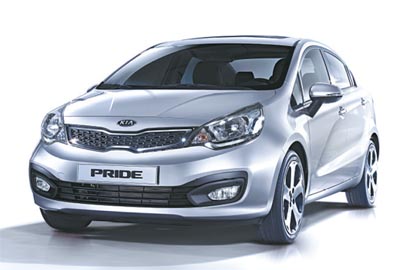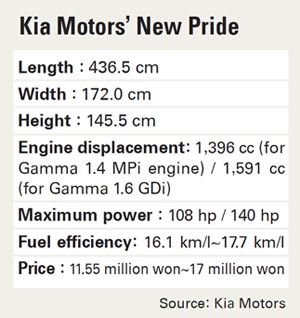New Pride a prudent choice, but lacking in punch

The overall impression I got after test driving Kia Motors’ all-new Pride was that it is worth the investment, especially for young people in their 20s and 30s.
For 16.4 million won ($14,200), you get a 1.6-liter gasoline direct injection (GDi) engine, 140 horsepower and a decent rate of efficiency.
In other words, the subcompact delivers a good performance for its price and segment, which is why a consumer like me, seeking efficiency, was also lured by the vehicle.
The size of the engine and torque were secondary considerations.
Another of the car’s charms is its long history, which reminds me of the Korean saying, “All that is ancient is beautiful.”
The first-generation Pride was released in 1987, representing a new dawn in the country’s compact car industry.
Ever since, the Pride has been a witness to the joys and sorrows of the Korean people.
And hoping to extend its storied history, Kia unveiled its all-new Pride subcompact sedan back in September, with the ambitious aim of selling 5,000 units in 2011 on the domestic market and 105,000 overseas.

Development on the new Pride began back in 2006 under the project name “UB,” based on investment of 190 billion won.
This has seen the model transformed both inside and out from its predecessor, released in April 2005, which had both a different engine and design.
The new model is 11.5 centimeters longer (4.365 meters) and 2.5 centimeter wider (1.72 meters), while its wheel base has been extended by 7 centimeters.
It has also had 1.5 centimeters shaved off its height to lend it a slightly sportier look.
Armed with my great expectations, I took the 1.6-liter GDi out for a spin and found that its fuel economy rises to 17.7 kilometers per liter (42 miles per gallon) when using the car’s idle function, which automatically kills the engine when stationary.
The Pride also offers a heated steering wheel, cruise control, a push-button keyless start system - and six airbags and a next-generation vehicle dynamic control among its safety specifications.
The exterior looks simple, modern and youthful, while the front grille and lamps add a sporty touch.
Meanwhile, the car comes in 10 colors including flash beige, caramel yellow and signal red.
The interior puts an accent on convenience, efficiency and style.
One of the attractions is its large glovebox, where drinks can be cooled, especially in the hot summer months.
It also delivers a smooth ride.
As I pressed down on the accelerator, the Pride began to glide forward with almost no engine noise.
It was easy to handle and light, which might suit female drivers.
However, one thing I felt was missing was power.
As I hit 100 kilometers per hour (62 miles per hour) on the Olympic Highway that runs beside Seoul’s Han River, the engine was screaming.
But then, what better deal would I get for between 12.5 million won - for the 1.4-liter MPI (multiport injection) version - and 16.4 million won?
In sum, the specifications of the all-new Pride are satisfactory for the practical minded, but those with a hunger for power and speed may find themselves feeling a little frustrated.
By Lee Eun-joo [angie@joongang.co.kr]










with the Korea JoongAng Daily
To write comments, please log in to one of the accounts.
Standards Board Policy (0/250자)